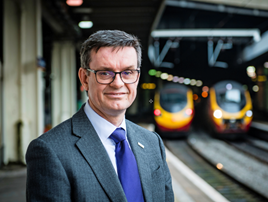Frobisher and his team at LNW are also busy preparing their submission to the next High Level Output Specification, which will outline the Government’s spending priorities for Control Period 6 (2019-24) when it is published later this year.
Affecting his route during CP6 and then CP7 (2024-29) will also be High Speed 2, now that Royal Assent has been granted for construction to begin later this year on Phase 1 of the route between London and Birmingham. HS2 will open in 2026, with operation of the first high-speed services to be included in the next West Coast Intercity franchise that begins in April 2019. Phase 2 between Birmingham and Manchester and Leeds is then expected to be completed by 2033.
Construction could also begin on the next phase of the East West Rail route that will eventually link Oxford and Cambridge, now that a company has been set up by the Department for Transport under the chairmanship of former Chiltern Railways MD Rob Brighouse (RAIL 822).
Brighouse has been tasked with examining ways to fund, build and operate the line independently of Network Rail, in an innovative experiment with private delivery that is intended to provide a benchmark for NR’s own internal processes for future enhancements.
Frobisher adds: “The Northern Powerhouse project, which we are now calling the Great North Rail project, is under way and is being built. It’s £1.4bn and has many exciting parts including the Ordsall Chord, new electric lines to Liverpool, faster trains to Liverpool and Manchester, and new platforms at Manchester airport.
“The money we invest in the Great North Rail project pays itself back many times over in the economy, and it’s really driving growth. £1.4bn is a huge sum of money, and there’s more being spent at the moment in the LNW route in the North than there is in the South, so Northern Powerhouse is really happening and it’s a real renaissance for the region.
“We’re putting together our strategic business plan for the next Control Period at the moment, and there will be route settlements for maintenance, operations and renewals.
“For enhancements we obviously have a portfolio of schemes, such as the Hope Valley capacity project which has slipped from CP5 to CP6, and then a whole programme of things across the North, in particular to support the investment TransPennine Express and Northern are making in new (electric) rolling stock.
“Further south there’s East West Rail, which is obviously a scheme that has real Government support and which the Secretary of State would like to accelerate. The early phase will interface with the Chiltern and West Coast Main Lines between Oxford and Bedford. Rob Brighouse has a good team, and we should look forward to new and innovative ways of delivering projects.
“The next really big thing for us will then be HS2 going north from Birmingham to Manchester, and the scale of redevelopment that it will bring to Crewe and Manchester Piccadilly stations. The build here at Euston is kicking off soon, and I look forward to working with HS2 Ltd on that and getting the high-speed platforms and train shed put in alongside ours, which will be really good.
“When it was going through Parliament with all the petitions it was a difficult political process, but now we’re into classic railway engineering, which is what we’re really good at.”
Frobisher concludes by looking ahead to the future control and command structure of NR. He says that although much progress has been made to shrink the centre of NR, the devolution process is still far from complete.
“It’s the people on the front line who know the answers to all the issues. We just need to free them up and let them get on with it, and working more closely with the operations team at all the TOCs I work with is what it’s all about.
“I think it’s a steady journey and I’d like to see more , but I think that’s coming through. In the next Control Period there will be route-based settlements so that’s real true autonomy as a route business, so we’ve made progress there.
“We’re part of the way there. I really appreciate the progress that’s been made so far, and I’m looking forward to the next steps.”
This feature was published in RAIL 824 on 8th April















Login to comment
Comments
No comments have been made yet.